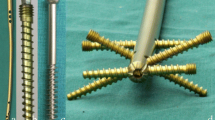Abstract.
The objective of this study was to review the use of intramedullary supracondylar (IMSC) nails for distal femoral fractures. We reviewed 24 fractures treated with second-generation IMSC nails. The fractures consisted of 18 type A1, one type A2, two type C1, one type C2, and two type C3 fractures. The relationships between clinical results and fracture type, approaches, and patient age were retrospectively reviewed. All fractures healed clinically and radiographically. Twenty-one patients maintained gait performance equivalent to that before injury. Average operating time was 108 min±43 min. ROM in the knee of all patients was –5°±6° in extension and 102°±38° in flexion. Extension lag was influenced by surgical approach. The final knee arc was inversely correlated to patient age (R: 0.49, P<0.05). There were three varus/valgus deformities, two cases with loosening, and two with breakage of the distal locking screws, but no failure of the nail itself. Second-generation IMSC nailing for distal femur fractures was satisfactory in patients younger than 60 years of age.
Résumé.
Le but de cette étude était de réexaminer l'utilisation de broches supracondyliennes intramédullaires (SCIM) pour des fractures fémorales distales. Nous avons réexaminé vingt-quatre fractures traitées avec des broches SCIM de seconde génération. Les fractures se composaient de 18 fractures de type s A1, d'une de type A2, deux de types C1, une de type C2 et deux de types C3. Les relations entre les résultats cliniques et le type de fracture ainsi que l' abord et l'âge du patient furent éxaminé s rétrospectivement. Toutes les fractures étaient cliniquement et radiographiquement consolidées. Vingt-et-un malades présentait les même capacité s de marche qu' avant la lésion. La durée moyenne de l'opération était de 109 min ± 43 min L'amplitude des mouvements du genou de tous les patients était de –5° ±6° d'extension et de 102° ±38° de flexion. La perte d'extension fut influencée par la voie d'abord chirurgicale. L'amplitude final du genou était inversement en corrélation avec l'âge du patient (plage: 0,49, p<0,05). Il y avait trois déformations varus/valgus, deux mobilisation du clou et deux ruptures des vis de verrouillage distales, mais pas de défaillance du clou lui-même. Le brochage SCIM de seconde génération pour des fractures distales de fémurs était satisfaisant chez les patients âgé s de moins de 60 a ns.
Similar content being viewed by others
Author information
Authors and Affiliations
Additional information
Electronic Publication
Rights and permissions
About this article
Cite this article
Watanabe, .Y., Takai, .S., Yamashita, .F. et al. Second-generation intramedullary supracondylar nail for distal femoral fractures. International Orthopaedics (SICOT) 26, 85–88 (2002). https://doi.org/10.1007/s00264-001-0312-6
Accepted:
Issue Date:
DOI: https://doi.org/10.1007/s00264-001-0312-6




